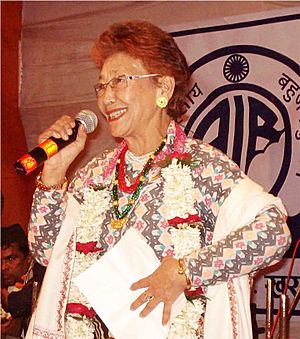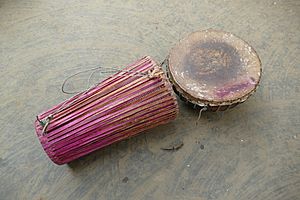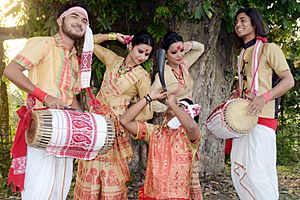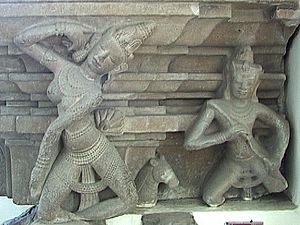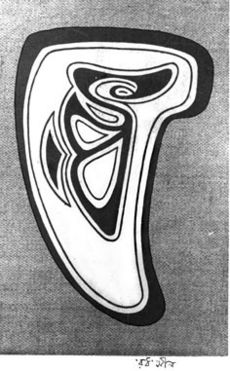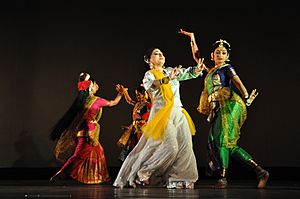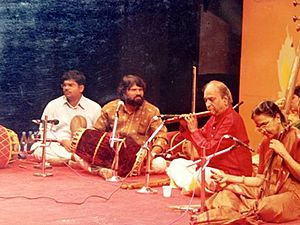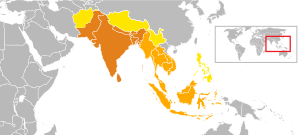Music of India facts for kids
Indian music is super diverse, just like India itself! It includes many types of music, like classical, folk, rock, and pop. Music has been a big part of Indian life for thousands of years. It started as an important part of religious and social events.
Contents
- History of Indian Music
- Classical Music
- Folk Music
- Popular Music in India
- Indian Music Around the World
- Organizations Promoting Indian Music
- See also
History of Indian Music
Indian music has a very long and interesting history.
Early Music (Pre-history)
Even 30,000 years ago, ancient cave paintings in places like Bhimbetka rock shelters in Madhya Pradesh show people dancing. Later cave art from the Stone Age shows musical instruments like Gongs, bowed lyres, and daf drums.
Around 4000 BCE, early musical instruments made of polished stone were found in Odisha. Sculptures from places like Ranigumpha Caves also show people playing instruments, singing, and dancing.
Ancient Times (Indus Valley and Vedic Eras)
The famous "Dancing Girl" statue from the Indus Valley civilization (around 2500 BCE) shows how important dance was. Paintings from that time also show people with drums.
The ancient Vedas (around 1500-800 BCE), which are sacred Hindu texts, mention music and performing arts. The idea of Tala (rhythm patterns) comes from these ancient texts. Later Hindu texts like the Ramayana (500-100 BCE) talk about different musical instruments, singing styles, and dance by celestial beings called Apsaras and Gandharvas.
In ancient Tamil literature, starting from Tholkappiyam (500 BCE), there are many mentions of music and Panns. Panns were melodic styles used in ancient Tamil music. These panns eventually developed into the seven-note Carnatic Sargam system.
Medieval Period
In the early 1300s, during the rule of the Khiljis, there were music shows and competitions between Hindustani and Carnatic musicians. From the 1500s onwards, many books were written about Indian music, explaining its rules and styles.
Modern Times (20th Century)
In the 1960s, famous Western musicians like John Coltrane and George Harrison started working with Indian musicians. They even used Indian instruments like the sitar in their songs. This led to a mix of Indian and Western music. By the late 1980s, British-Indian artists combined Indian and Western styles to create a new sound called "Asian Underground." Today, you can hear Indian film music and Bhangra in American hip-hop songs.
Classical Music
India has two main types of classical music:
- Carnatic music: Popular in South India.
- Hindustani music: Popular in North, East, and Central India.
Both styles use basic ideas like Shruti (microtones), Swaras (notes), Alankar (decorations), Raga (melodies), and Tala (rhythmic patterns). The musical scale has 22 small segments called Shrutis.
The seven main notes in Indian classical music are called Sapta Svara or Sapta Sur. They are Sa, Re, Ga, Ma, Pa, Dha, and Ni. These are short forms of longer Sanskrit names. Sa and Pa are always "pure" notes and don't change, so they are called Achal Svaras. The other notes (Re, Ga, Ma, Dha, Ni) can change slightly and are called Chal Svaras.
- Sa, Re, Ga, Ma, Pa, Dha, Ni - These are the basic, pure notes.
- Re, Ga, Dha, Ni - These notes can also be played as "soft" (Komal) versions.
- Ma - This note can also be played as a "sharp" (Tivra) version.
India's Sangeet Natak Academy recognizes eight classical dance and music forms, including Bharatanatyam and Kathak.
Carnatic Music
Carnatic music started in South India around the 1300s-1400s. It's mostly melodic, meaning it focuses on the tune. It has set compositions, but musicians also add their own improvised parts. The main focus is on singing, and even when instruments play, they try to sound like a voice.
Purandara Dasa is known as the father of Carnatic music. Later, Tyagaraja, Shyama Shastry, and Muthuswami Dikshitar are considered the "Trinity" of Carnatic music. Every December, the city of Chennai in India hosts the world's largest cultural event, the Madras Music Season, which is all about Carnatic music.
Hindustani Music
Hindustani music also comes from ancient times, but it changed a lot around the 1200s-1300s due to influences from Islamic and Persian music. It has a rich history and is popular in India, Pakistan, and Bangladesh. Unlike Carnatic music, Hindustani music was greatly shaped by the Mughal rulers and their Persian musical styles. Some popular classical styles include dhrupad and khyal.
Light Classical Music
There are many types of music that are called "light classical" or "semi-classical." These include Thumri, Dadra, Bhajan, and Ghazal. These forms focus more on showing emotions to the audience, unlike the stricter classical forms.
Folk Music
India has a huge variety of folk music, with different styles in almost every region.
Tamang Selo
This music comes from the Tamang people and is popular among Nepali speakers in India. It uses traditional instruments like the Madal, Damphu, and Tungna. Tamang Selo songs can be fast and fun or slow and sad. They often tell stories about love, sorrow, happiness, or daily life.
Hira Devi Waiba is famous for being a pioneer of Nepali folk songs and Tamang Selo.
Bhangra and Giddha
Bhangra is a lively dance music from the Punjab. It's very energetic and often played at celebrations. Giddha is a similar dance performed by women in Punjab.
Bihu and Borgeet
Bihu is a New Year festival in Assam, celebrated in mid-April. Bihu dances and songs are a big part of this festival. The songs are full of energy, welcoming spring. They use traditional Assamese drums (dhol), Pepa (made from buffalo horn), and Gogona.
Borgeets are lyrical songs composed by Srimanta Sankardeva and Madhavdeva in the 1400s-1500s. They are often used to start prayer services in monasteries.

Dandiya
Dandiya or Raas is a traditional dance from Gujarat, performed with sticks. The music for Dandiya comes from traditional folk tunes. Another related dance and music style is Garba.
Gaana
Gaana is a rap-like music style from Chennai, India. It has developed over the past two centuries, blending different influences. Gaana songs are performed at weddings, shows, and even funerals. They often talk about life's struggles and feelings of sadness. Recently, Gaana has become popular in mainstream Tamil films.
Lavani
Lavani means "beauty" and is a very popular dance and music form from Maharashtra. It's a key part of Maharashtrian folk performances. Women usually sing the songs, which are performed to the exciting beats of the 'Dholaki' drum. The dance is performed by women wearing nine-yard saris.
Manipuri Music
The music and dance of Manipur are a big part of the Manipuri people's heritage. They believe they are descendants of the Gandharvas, who were celestial musicians and dancers in ancient Indian texts. The Manipuri dance called Jagoi has a long history and shares similarities with ancient Indian dance forms.
Rabindra Sangeet (Music of Bengal)
Rabindra Sangeet, also known as Tagore songs, were written and composed by Rabindranath Tagore. They are very popular in India and Bangladesh. Tagore wrote over 2,230 songs in Bengali, using both classical and folk music styles. He also wrote the national anthems of India and Bangladesh.
Rajasthani Music
Rajasthan has many musical groups, like the Langas and Manganiyars. Their music is soulful and diverse. Rajasthani music uses many instruments:
- String instruments: Sarangi, Ravanahatha, Kamayacha.
- Percussion instruments: Large Nagaras and Dhols, small Damrus.
- Wind instruments: Shehnai, Poongi, Algoza.
This music is also often heard in Bollywood films.
Popular Music in India
Dance Music
"DJ music" is very popular in India, especially among young people. It's played at nightclubs, parties, and weddings. This music often takes songs from Indian movies and pop music, adding modern beats and instruments.
Movie Music (Filmi)
The biggest type of popular music in India is filmi, which means songs from Indian films. These songs make up most of the music sales in India. The film industry has always respected classical music while also using Western instruments to support Indian melodies.
Many famous music composers like A. R. Rahman and Pritam have created film music. Traditionally, actors don't sing their own songs in Indian films. Professional playback singers sing the songs, and the actors lip-sync on screen. Famous playback singers include Lata Mangeshkar and Asha Bhonsle.
Pop Music
Indian pop music mixes Indian folk and classical music with modern beats from around the world. Pop music really took off in the region with Ahmed Rushdi's song ‘Ko Ko Korina’ in 1966.
Many Indian pop songs come from the film industry. However, some singers like Daler Mehndi and Alisha Chinai became popular outside of films. Recently, "remixing" old Indian movie songs with new beats has become a big trend in Indian pop.
Patriotic Music
Patriotic songs have always inspired people in India. The national anthem, "Jana Gana Mana" by Rabindranath Tagore, and the national song, "Vande Mataram", are very important. Songs like "Mile Sur Mera Tumhara" and "Maa Tujhe Salaam" help bring people together and celebrate India's unity in diversity.
Western Music in India
India has also adopted Western music styles, often mixing them with Indian sounds to create new global genres.
Goa Trance
Goa trance is an electronic music style that started in Goa, India, in the late 1980s. It has unique basslines and mixes India's spiritual culture with Western electronic music.
Jazz and Blues
Jazz in India first became popular in cities like Calcutta and Bombay in the 1920s. The 1930s to 1950s were the "golden age" of jazz in India, with many international jazz musicians visiting. Many Goan musicians played jazz in Bombay nightclubs and also worked in the Bollywood film industry, bringing jazz to Hindi films.
Rock and Metal Music
Indian Rock
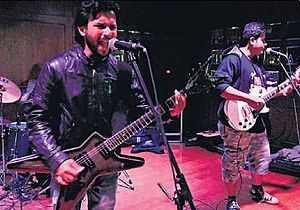
Rock music in India started in the 1960s when bands like the Beatles visited and collaborated with Indian musicians. This led to "raga rock". Indian rock bands became more well-known in the late 1980s. When MTV came to India in the 1990s, it exposed people to different rock styles like grunge and speed metal. Cities like Bangalore, Mumbai, and Delhi are now major centers for rock and metal music.
Raga Rock
Raga rock is rock or pop music with a strong Indian influence, using instruments like the sitar and tabla. It became popular in the 1960s, especially with the Beatles' song "Norwegian Wood (This Bird Has Flown)", which was one of the first Western pop songs to use a sitar. George Harrison of The Beatles became very interested in Indian music and helped make raga rock popular.
Indian Music Around the World
With 17.5 million people of Indian origin living abroad, the Indian diaspora helps spread India's culture globally.
Influence on Other Music Styles
Ancient Influence on Southeast Asian Music
As Indian culture spread to Southeast Asia, it influenced music and dance there. Many Southeast Asian kingdoms adopted Indian languages and traditions.
Indonesian and Malay Music
In Indonesian and Malaysian music, the popular Dangdut folk music style is partly influenced by Hindustani music. It uses a tabla and gendang drum beat.
Thai Music
Thai literature and drama are greatly inspired by Indian arts and Hindu stories. The Thai version of the Ramayana epic, called Ramakien, is very popular. Many classical Thai dances also draw inspiration from this epic.
Philippines
Filipino epics and chants are inspired by Indian Hindu stories like the Ramayana and Mahabharta. The Kudyapi, a native Filipino guitar, is influenced by Indian classical music ideas of melody and scale.
Fusion with Other Nations' Music
Sometimes, Indian music is mixed with traditional music from other countries. For example, the band Delhi 2 Dublin combines Indian and Irish music. Bhangraton is a mix of Bhangra and reggaeton.
Western World Music
Film Music
Indian film composer A. R. Rahman wrote music for the musical Bombay Dreams. The Bollywood film Lagaan (2001) was even nominated for an Oscar! Western musical films like Moulin Rouge! (2001) were inspired by Bollywood musicals, helping to bring them back into popularity.
Hip Hop and Reggae
In recent years, American hip-hop has used Indian film music and Bhangra. Famous hip-hop artists have sampled songs from Bollywood movies and worked with Indian artists. For example, The Black Eyed Peas sampled Asha Bhosle's song "Yeh Mera Dil" in their hit "Don't Phunk With My Heart".
Jazz
In the early 1960s, jazz musicians like John Coltrane and Miles Davis started mixing jazz with Indian music. George Harrison of The Beatles played the sitar on "Norwegian Wood (This Bird Has Flown)" in 1965, which made many people interested in Indian music. Guitarist John McLaughlin even learned Carnatic music and used it in his band Shakti.
Rock and Roll
In the late 1970s and early 1980s, rock and roll mixed with Indian music became well-known in Europe and North America. Ali Akbar Khan's performance in the US in 1955 helped start this trend.
Technopop
The influence of Indian film music can be seen in popular music worldwide. The Black Eyed Peas' song "Don't Phunk with My Heart" was inspired by two 1970s Bollywood songs.
Influence on National Music Scenes
Bollywood has become a powerful way for India to share its culture globally. It has changed how people around the world see India.
Africa
Indian films and music are popular in many parts of Africa, like Egypt and Nigeria. They have influenced local clothing, songs, and stories.
Americas
Caribbean
Indo-Caribbean music is common in places like Trinidad and Tobago and Guyana. It reflects their Indian heritage. Women sing Hindu religious songs and folk songs. chutney music is a popular dance music style that developed there.
Latin America
Indian music and Hindi movies are popular in Suriname and Guyana because of their large Indian communities.
North America
In the new millennium, American hip-hop has featured Indian film music and Bhangra. Artists like Timbaland and Jay-Z have used Indian sounds or collaborated with Indian artists.
Asia
South Asia
Because of shared culture and language, Indian music and Bollywood films are very popular in neighboring countries like Afghanistan, Pakistan, Bangladesh, and Nepal.
West Asia
West Asia has many people of Indian origin who enjoy Indian music. Indian films and music are also popular with local people in Arab countries.
Europe
UK
In the late 1980s, Indian-British artists combined Indian and Western traditions to create the Asian Underground music style. Musicians like Nadaka and Krishna Das have also blended Indian classical music with Western styles.
Oceania
Indian music and movies are very popular in Fiji due to its large Indian population. They are also popular in Australia and New Zealand.
Organizations Promoting Indian Music
Sangeet Natak Akademi is a national academy set up by the Government of India in 1952 to promote performing arts. It gives awards to artists and has established many institutions for different dance and music forms across India.
See also
 In Spanish: Música de la India para niños
In Spanish: Música de la India para niños
- Indian classical music
- Indian classical dance
- Indian musical instruments
- Indian Music Industry
- Music of South Asia



